¶ 2020-12-22
What's New?
General Syncrofy
- More Options Than Ever Before! You can now plot numerical fields on the x-axis of most dashboard widgets. For example, you can plot order lifecycles by lead time and days open or ASNs by number of orders (or vice versa)

Bug Fixes
- This release also several small improvements and bug fixes.
Syncrofy for Supply Chain Only
- Better Change Management. Your orders are as dynamic as your business. That’s why we’ve given you the ability to add, remove, and update portions of your order—enabling you to reflect what was communicated when the buyer sends a purchase order change document and when the seller acknowledges an order via a purchase order acknowledgement. Any modifications made in a POC or POA will immediately update calculations such as fill rate, so you’re always getting the most accurate view of the order.
- Receiving Got an Upgrade. Syncrofy can now interpret Receiving Advice (861) documents in order lifecycles. That means if you use that document, Syncrofy will now mark a shipment as “received” and will call out any differences where the quantities don’t quite match up. Additionally, if you use the 861 as an “Acceptance Certificate” Syncrofy will also record the quantity accepted vs. received for even further insight.
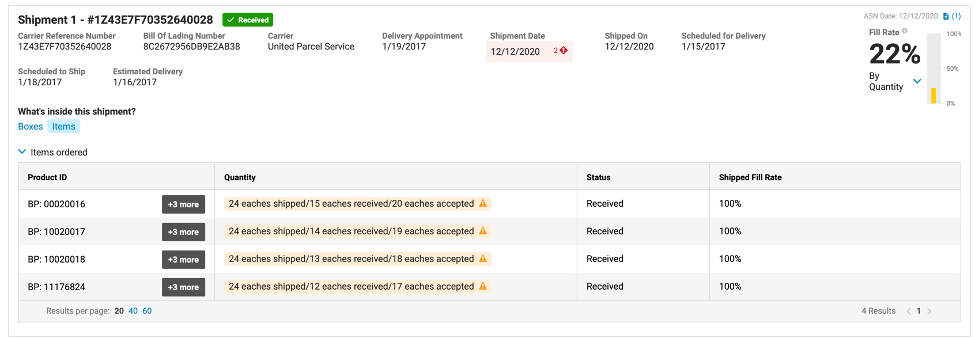
¶ 2020-12-05
What's New?
General Syncrofy
- Trading Partner Management Is Even Easier. We updated how you manage and resolve unknown partners and organizations a few months ago to make the process more streamlined. With your feedback, we’ve added more info about the documents that use this identifier so you can make better-informed decisions when it comes to resolving the unknown identifier. You’ll now see important data like how many documents were sent/received using these identifiers and links to affected documents for easy navigation if more detail is required.
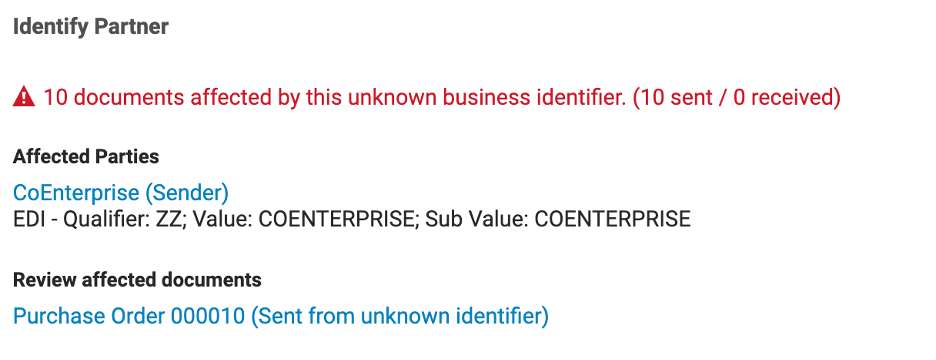
- Can’t Stop, Won’t Stop Improving Dashboards! Importing a dashboard template just got a facelift and now includes a dedicated Import Template button and Create New dashboard buttons.

- The template menu is also easier to use and includes search functionality so you can find the type template you need to answer your specific business question.
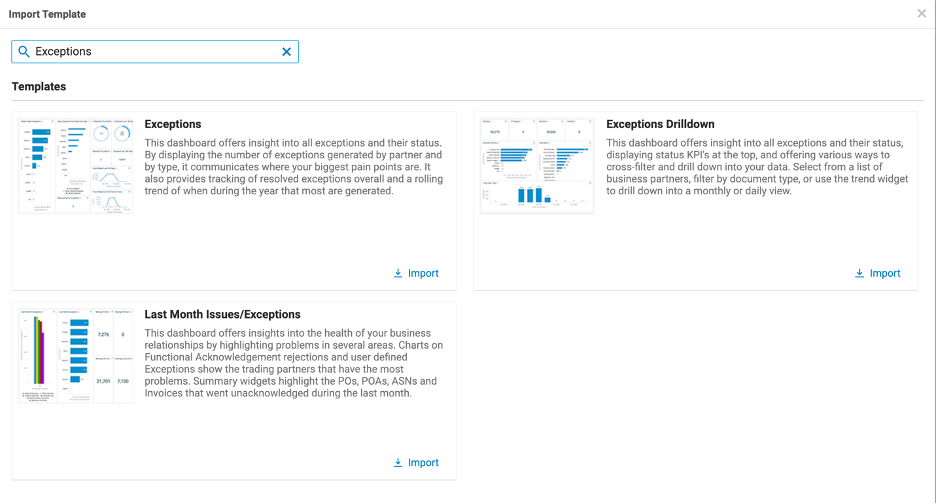
- All of the Templates! We added templated views to the main Documents and Exceptions screens. You’re now able to search for, favorite, and quickly access these views on their respective list screens. The Documents screen includes:
Documents with Errors – Get quick visibility into all of the errors reported by you or your trading partners via functional acknowledgements and application advice documents. Use this to judge a partner’s improvement over time or use it to debug and prevent future errors in your systems.
Rejected Purchase Orders - Last 90 Days – View all purchase orders that were rejected during the last 90 days so you know exactly what orders failed and can take steps to reorder or find new product to order elsewhere.
Last Week’s Unacknowledged Orders and Last Week’s Unacknowledged Invoices – Gain insight into all orders or invoices that have yet to be acknowledged so you can easily find the ones you need to follow-up on (acknowledged orders and paid invoices are a thing of beauty).
The Exceptions screen also has a new template for File Processing Exceptions that filters out only those exceptions. This filter is favorited by default so it will appear at the top of the screen for you automatically. Feel free to favorite or unfavorite any views you have saved for quick and easy access!

Syncrofy for Supply Chain Only
- Gimmie Your Digits. We now include contact information from the original purchase order on the “Order Information” tab on the Order Detail Screen. This will let you know who to contact at your trading partner regarding the order. It’s just another way we’re putting critical information at your fingertips to make your life easier.
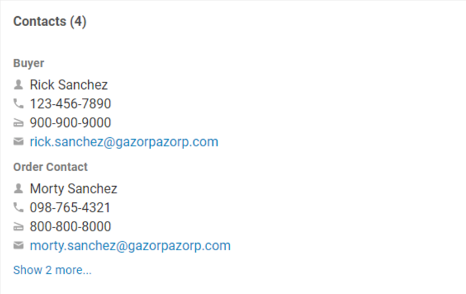
¶ 2020-11-20
What's New?
- Stay in the Know with Your Orders. Syncrofy now proactively notifies you when a shipment is late for an order. To set this up, simply head over to “Order Lifecycle Configurations” and customize what you consider to be an on-time shipment. For example, you can ensure that the shipped date comes before the requested ship date so you can stay on the same page with your trading partners and ensure your orders remain on-time.

- Onboarding Just Got Easier! You can now download a list of all unidentified partner IDs as a CSV file. Fill out the missing information and re-upload all at once to quickly and efficiently resolve your unknown identifier exceptions.
- More Dashboard Upgrades. Finding your favorite dashboard is now easier than ever. You can now search for your dashboards by name and save them as favorites to access them more easily. Additionally, we made counting things much simpler! If you just want to see the number of orders or documents, there’s no extra work required on your part as the dashboard will show it automatically.
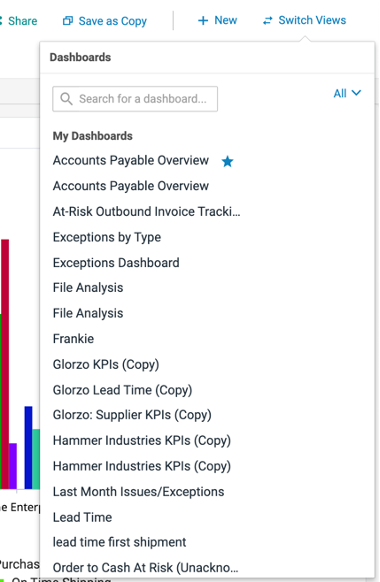
Bug Fixes
- This release also includes more than a dozen other bug fixes, performance, and interface improvements.
¶ 2020-10-27
What's New?
- Download All theThings! You've always been able to analyze your data in Syncrofy by cross filtering and drilling down on your dashboard. Now you can export the filtered underlying data as a .CSV to take into another application for further analysis.
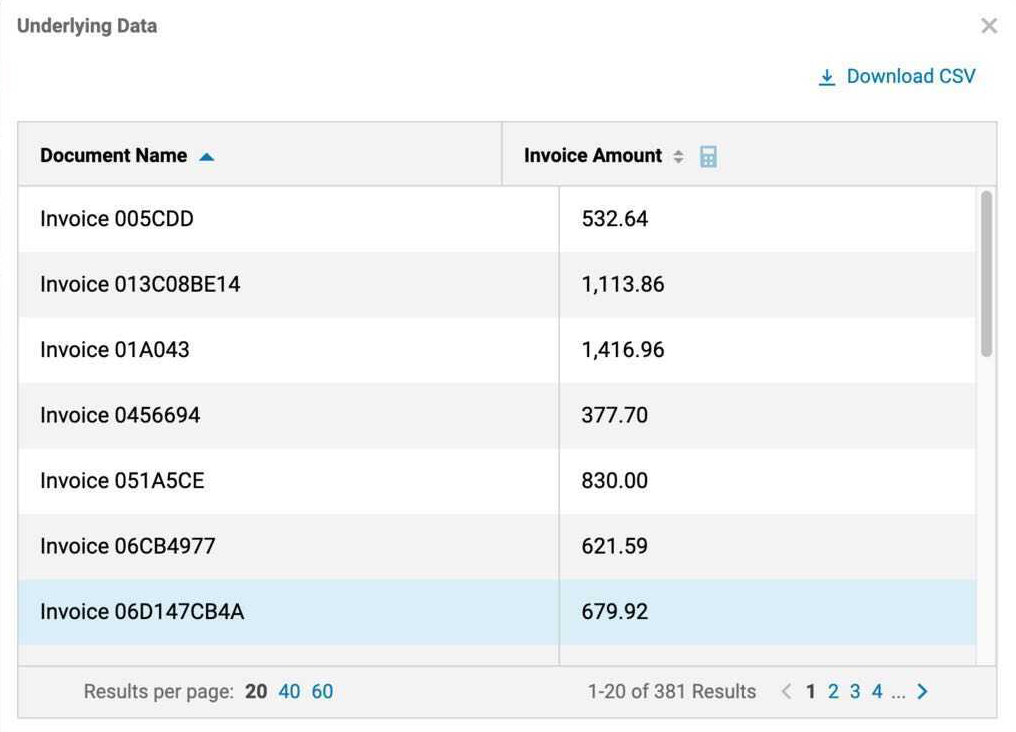
- Get Insights Faster Than Ever. Bar charts will now automatically show the label for the value of each bar if it will fit. If it doesn’t fit you can still see the value on hover.
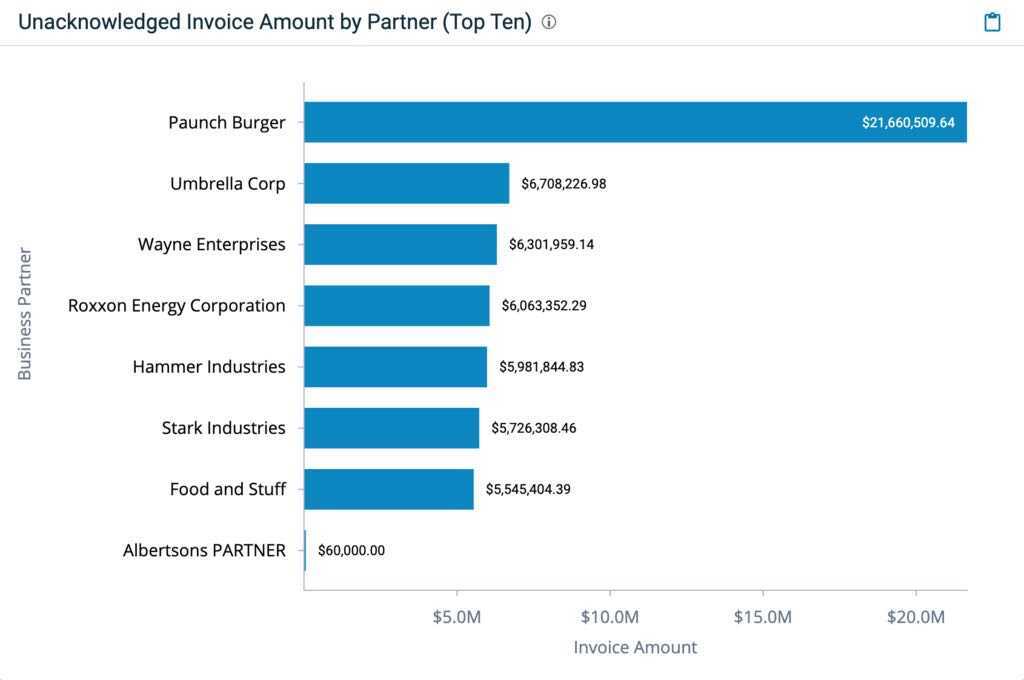
- Fill Rate Calcs Got an Upgrade. Behold! We've made some major improvements to Syncrofy’s ability to accurately calculate fill rates. Most notably, Syncrofy is now better at managing when one product is shipped in multiple boxes or pallets, respecting when transactions have been rejected and better at handling different units of measure.
Bug Fixes
- This release includes some really nice performance improvements, general improvements, and bug fixes.
¶ 2020-10-13
What's New?
- Bulk Upload is Slimmed Down! Our bulk partner upload mechanism was simply too bulky for us and our users. So, we replaced the XML version of it with a much more user friendly CSV upload. Simply download and fill out the easy-to-use CSV template with trading partner information (name, business identifiers and even contacts you have for that company), then just upload the data and let Syncrofy do the rest!
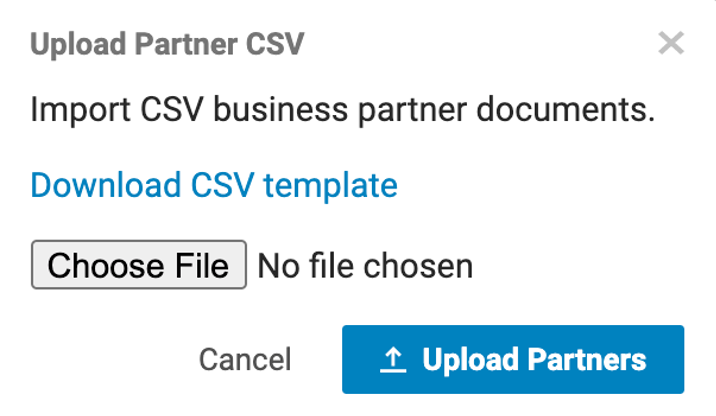
Bug Fixes
- As always, this release includes some small bug fixes as well to enhance your Syncrofy experience.
¶ 2020-08-11
What's New?
- Get Your Ship Together! Shipment reconciliation is headed to the Syncrofy for Supply Chain Beta! Everyone can agree that shipping can get messy and complicated at times. Let Syncrofy do the heavy lifting and inform you on the current state of your order and how it’s been shipped to date. Syncrofy now calculates important KPIs out-of-the-box such as fill rate, lead time, and alerting you about unexpected goods that were shipped, but not ordered.
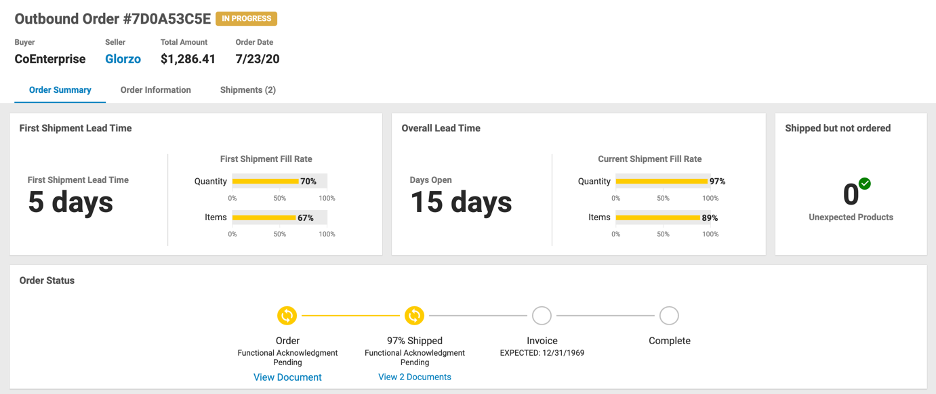
- But we’re not stopping there! Syncrofy will also now provide granular line item detail into the shipment compared to the original order. Easily spot quantity discrepancies with easy-to-read contextual data and fill rate calculated down to the individual line item.

- And last, but certainly not least, you can take all this data and analyze it using Syncrofy’s existing dashboarding and reporting capabilities. Create a data visualization in just a few clicks to see things like "Average Fill Rate by Business Partner” or "Open Orders Last 30 Days.”
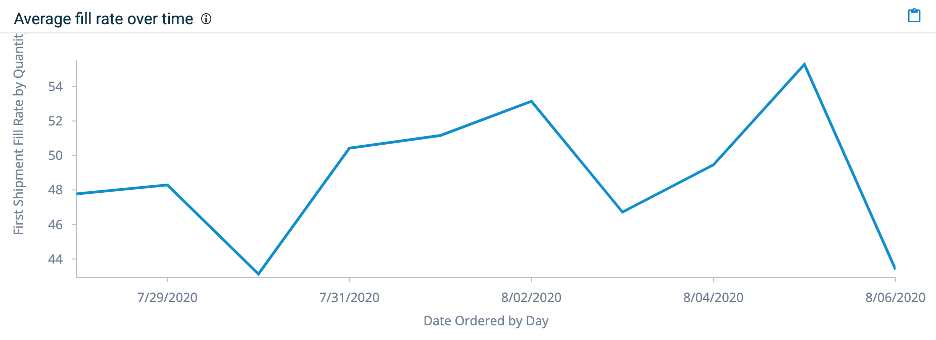
¶ 2020-07-21
What's New?
- We’ve Expanded ASN Support. It’s more robust as we’ve improved how we display tares/pallets, packs/boxes, and items. They’re all arranged hierarchically, no matter the hierarchy in the ASN—and if you've had problems in the past using the ASN for reconciliation, those problems should be resolved. If you haven’t used the ASN in Syncrofy for reconciliation, now would be a great time to start!
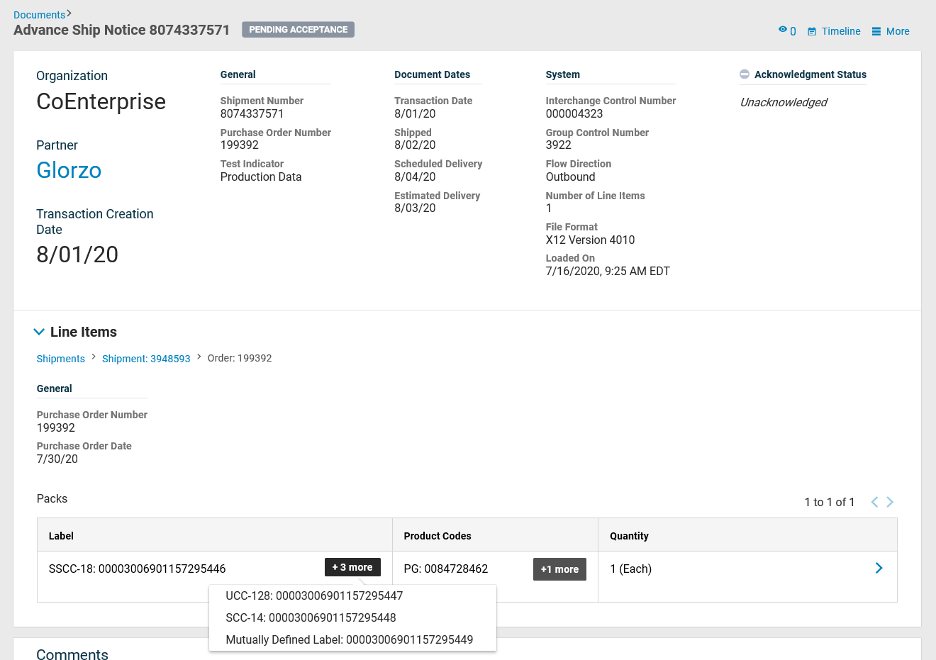
- We’re also including the Bill of Lading, Carrier’s Reference Number, and Tracking Number on the ASN. You’ll be able to view these values in all of your ASN document list views—making it easier to export a list of shipments with their tracking IDs.

- Trading Partner Management Got a Major Upgrade! Do you add new trading partners regularly? If so, you may have found it a little tedious to set them up in Syncrofy. For every document with identifiers Syncrofy doesn’t recognize, you are alerted of a Missing Partner Exception. This list can quickly become overwhelming. However, the good news is we’ve completely redesigned this process from the ground up! Click here to read the help article and learn more.
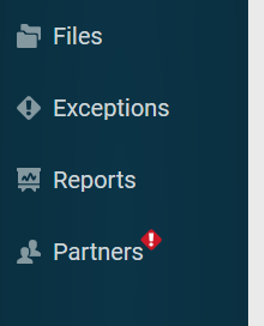
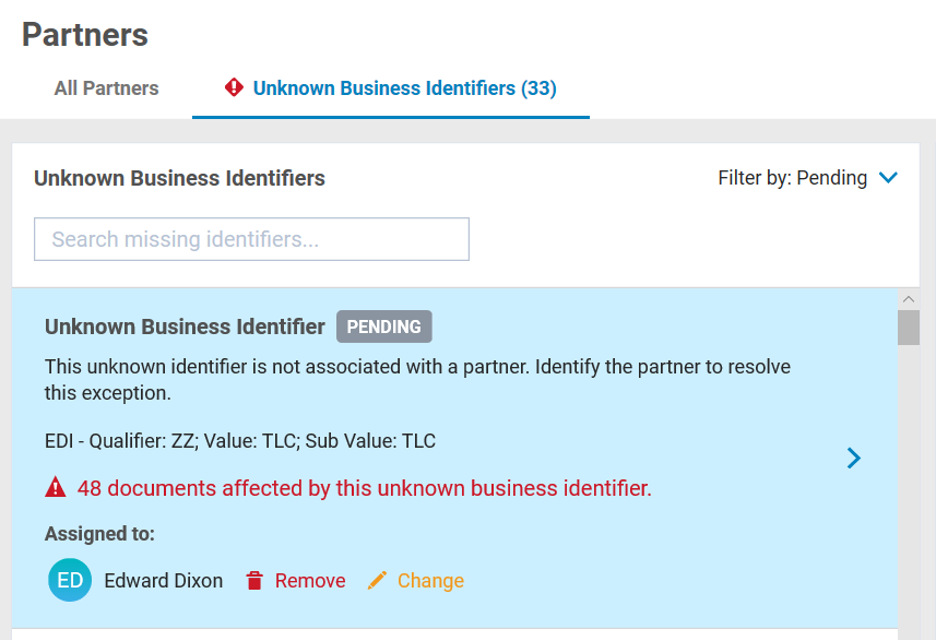
¶ 2020-06-04
What's New?
- Easily Update Partner Names. Ever add a new business partner and mistype their name? Or maybe your business partner merged with another company or rebranded, and you still see them in Syncrofy under their old name. This used to be a complicated fix—but now it’s as easy as going to the partner’s page, clicking the Edit icon next to the partner’s name, and updating the name. That change will be reflected on all documents for that partner in search, document list views, and dashboards. Remember, if the partner has a lot of documents, give it a few minutes to update.
- More Ways to See Errors. We’ve made some major upgrades to how Syncrofy displays EDI errors. If a document has a Functional Acknowledgment (997) or Application Advice (824) with errors, they will now display on the original Purchase Order, Invoice, Advance Ship Notice, etc. You’ll also be able to view these errors in the Document List Views, by choosing the filter “Has Errors,” selecting “True,”and adding the column “Error Summary. We’ll be soon enhancing the CSV download so you can easily perform additional analysis on errors (type, frequency, segments, etc.).
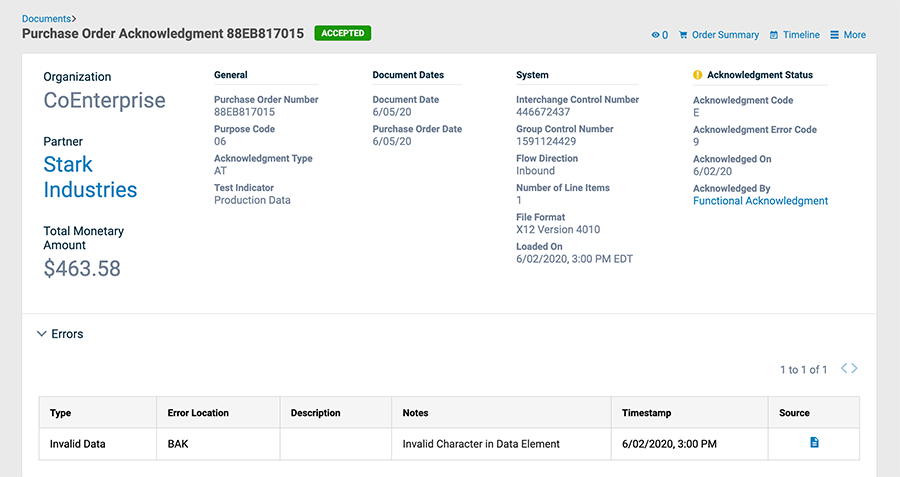
- Note: If you don’t see this new error functionality, let us know—it requires a Local Agent update on your end and a quick configuration change on ours.
- Even More Exceptional. We improved our exception popovers so now you can assign exceptions and resolve them with one click, rather than having to open another menu.
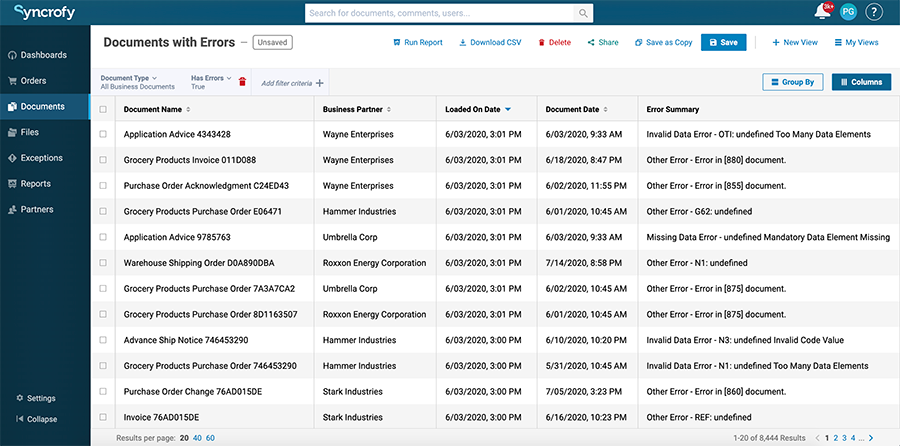
Bug Fixes
- As always, this release includes some small bug fixes as well to enhance your Syncrofy experience.
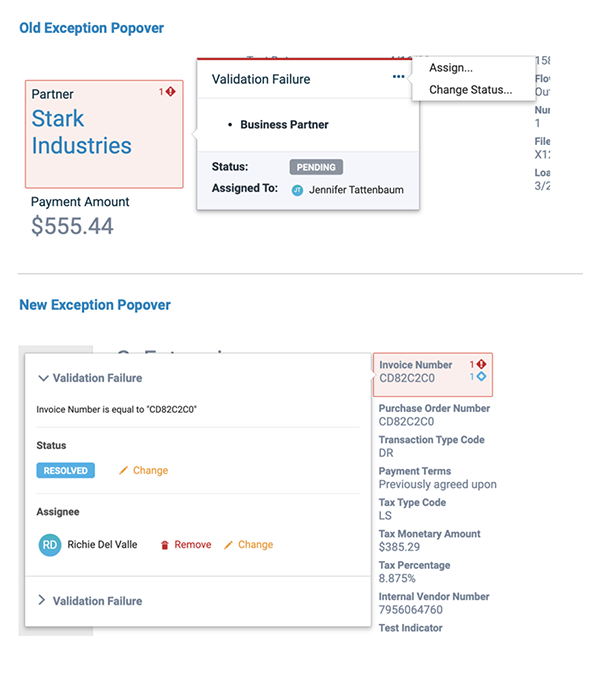
¶ 2020-05-19
What's New?
- An Easier Way to Find Document Lists. You can now search by the name of the document list view, or favorite up to three lists! They’ll then appear at the top of the Documents list page so you can get to them with one click.
- Wondering Who to Contact When an Order Has a Problem? That information may be in the PER segment in the document, but you couldn’t see it in Syncrofy. Well, now you can! Look in the Addresses and Points of Contact section. Syncrofy displays all of the contacts included in the EDI. You’ll have to update your Local Agent to see this new information.
- Dashboards—Line Charts with Splits. If you’ve tried to create a line chart comparing last year’s data to this year’s data, or split by trading partner and limit it to just your top five partners, you may have seen some strange results. That won’t happen anymore! You can limit the number of lines in your chart, and everything will look great!
Bug Fixes
- Lots of other small but important bug fixes, including continued migration to our new messaging service.
¶ 2020-05-12
What's New?
- Getting Strict with Correlations. Business partners in Syncrofy allow us to group all of the documents for a single partner together, regardless of what identifiers each document uses. For example, if both identifiers “ZZ/ABC/ABC” and “ZZ/123/123” belonged to trading partner “Acme” then all documents with those identifiers will be labeled as “Acme.” Taking it a step further, Syncrofy will also correlate purchase orders with invoices or functional acknowledgments even if the IDs do not match. Most of the time it’s peachy but sometimes users may want greater control—which is where strict ID checking comes in.
You can now tell Syncrofy to only correlate documents when the IDs match exactly (either globally for all identifiers or specifically for certain partners). This means that both “ZZ/ABC/ABC” and “ZZ/123/123” will be labeled as “Acme.” However, a purchase order for “ZZ/ABC/ABC” and an invoice for “ZZ/123/123” will no longer show up on the same timeline. To learn more about this new advanced setting check out the Help article. - We Organized Organizations. It was time for some spring cleaning so we reorganized the old “Company Profile” section of the Settings page and renamed it “Organizations” to better reflect the purpose of that page.
Bug Fixes
- Lots of other small bug fixes and improvements to keep everything running smoothly.
¶ 2020-03-10
What's New?
- Must Go Faster! Increased loading performance of Document Detail Screens by 10 times.
Bug Fixes
- Lots of other small but important bug fixes.
¶ 2020-01-15
What's New?
- Extreme Makeover: Tables Edition! Tables throughout Syncrofy have been given an overhaul. The same treatment we gave tables in Documents, Files, and Exceptions a few months ago has been applied to the rest. This includes columns that auto size to the content, sticky headers, and other nice features to enhance the readability and usability of Syncrofy. This is just the first pass with more refinements in the coming weeks!
Bug Fixes
- Fixed: Syncrofy now supports underscores in business identifiers. Previously, Syncrofy would choke when it came across these IDs, but as you’d expect, we’ve taught our flagship software some new tricks to effectively handle these IDs.
- Fixed: We had an issue where two related documents that were processed at nearly the exact same time would not properly correlate to each other. To prevent this, correlated documents will now be processed sequentially to avoid this annoying race condition.
- A few other bug fixes and improvements.
¶ 2020-01-07
What's New?
- Excelsior-er! Check out the new fixes to the Excel download for invoices, specifically around separating some fields to make printing easier!
- So fresh and so clean. We gave a general polish to and cleaned up a few UI components that were starting to show their age to make them look clean, fresh, and modern. Cleaned up radio buttons, toggles, cards, and modals as well as made a minor visual tweak to the Settings page. While we were at it, we also fixed a number of other UI issues including some annoying ones such as certain 852s failing to load, menus rendering in a weird order, and some dashboard rendering issues.
- As always, we also made some additional bug fixes and improvements to enhance your experience.
Local Agent Update
- Did you think referencing purchase orders in the Planning Schedule (X12 830) or the Receiving Advice (X12 861) should be available in Syncrofy? We agree! We are now exposing the PO number on both those documents, correlating them in the Timeline and making them available in Search! Note: This functionality requires Local Agent v5.22.0 or later.